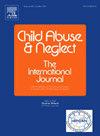Change in Child and Adolescent Needs and Strengths (CANS) scores over time among children and youth in out-of-home care: A latent growth curve analysis
IF 3.4
2区 心理学
Q1 FAMILY STUDIES
引用次数: 0
Abstract
Background
Children and youth in out-of-home care (OOHC) have significant behavioral health needs and may not receive relevant treatment. While the literature has urged implementation of standardized assessment of behavioral health needs, and specifically mental, emotional and social wellbeing, for these children and youth, little is known about the extent to which these needs improve over time.
Objective
The study purpose was to examine whether improvement in functioning was detected over time based on Child and Adolescent Needs and Strengths (CANS) scores, and how scores improved over time.
Participants and setting
The study examined scores for 6104 children and youth in OOHC between 2016 and 2022 in one state.
Methods
Total scores for six CANS domains (behavioral/emotional needs, risk behaviors, strengths, cultural factors, life functioning, caregiver resources and needs) were computed for children and youth at five timepoints at baseline and approximately every three months. To explore the trajectory of scores over time we used latent growth curve models and fit a series of increasingly complex models to identify the best fitting form.
Results
While initial levels of CANS domain scores each varied significantly across children and youth, on average CANS domain scores significantly decreased over time between T1 and T3, demonstrating overall improvement. Children and youth with higher initial levels experienced a faster rate of change T1–T3, which tended to slow from T3–T5.
Conclusions
Understanding whether behavioral health services after the identification of higher initial behavioral health needs contribute to the faster rate of improvement for these youth is an important area of future research. Identifying factors that account for between-youth variability in initial levels and rate of change is important to identify groups of youth who may be more (or less) at risk and to inform intervention.
儿童和青少年需要和优势(CANS)得分随时间的变化在儿童和青少年的家庭外护理:一个潜在的增长曲线分析
儿童和青少年在家庭外护理(OOHC)有显著的行为健康需求,可能没有得到相关的治疗。虽然文献已经敦促对这些儿童和青少年的行为健康需求,特别是心理、情感和社会健康进行标准化评估,但人们对这些需求随着时间的推移而改善的程度知之甚少。目的研究儿童和青少年的需求和力量(can)评分是否随着时间的推移而改善,以及评分如何随着时间的推移而改善。该研究检查了一个州2016年至2022年期间OOHC的6104名儿童和青少年的分数。方法在基线的五个时间点和大约每三个月计算儿童和青少年的六个can域(行为/情感需求、风险行为、优势、文化因素、生活功能、照顾者资源和需求)的总得分。为了探索分数随时间的变化轨迹,我们使用了潜在增长曲线模型,并拟合了一系列越来越复杂的模型,以确定最佳拟合形式。结果:虽然儿童和青少年的can结构域得分的初始水平各有显著差异,但在T1和T3之间,can结构域得分的平均水平显著下降,表明总体上有所改善。初始水平较高的儿童和青少年T1-T3变化速度较快,T3-T5变化速度趋于缓慢。结论在确定较高的初始行为健康需求后,了解行为健康服务是否有助于这些青少年更快的改善速度是未来研究的一个重要领域。确定导致青少年之间在初始水平和变化率方面存在差异的因素,对于确定可能面临更多(或更少)风险的青少年群体并为干预提供信息非常重要。
本文章由计算机程序翻译,如有差异,请以英文原文为准。
求助全文
约1分钟内获得全文
求助全文
来源期刊

Child Abuse & Neglect
Multiple-
CiteScore
7.40
自引率
10.40%
发文量
397
期刊介绍:
Official Publication of the International Society for Prevention of Child Abuse and Neglect. Child Abuse & Neglect The International Journal, provides an international, multidisciplinary forum on all aspects of child abuse and neglect, with special emphasis on prevention and treatment; the scope extends further to all those aspects of life which either favor or hinder child development. While contributions will primarily be from the fields of psychology, psychiatry, social work, medicine, nursing, law enforcement, legislature, education, and anthropology, the Journal encourages the concerned lay individual and child-oriented advocate organizations to contribute.
 求助内容:
求助内容: 应助结果提醒方式:
应助结果提醒方式:


